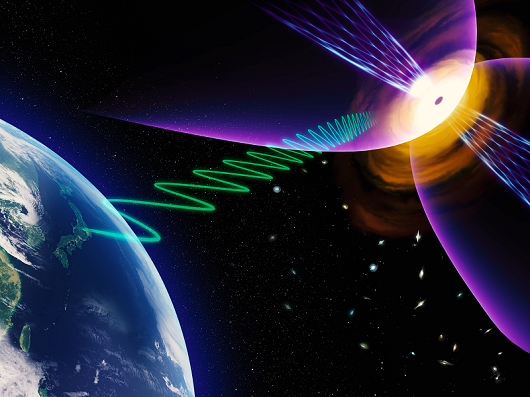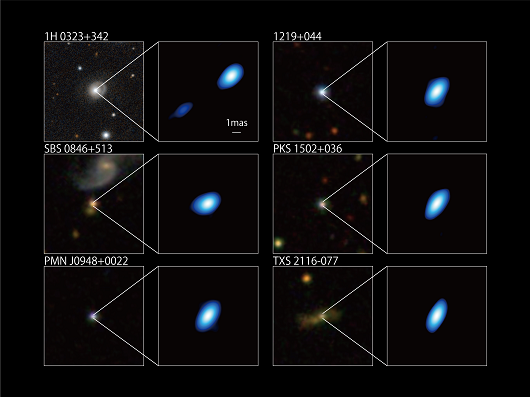| Topics | VERA NEWS | Others |
Hight Light
VERA NEWS
VERA Unveils Surroundings of Rapidly Growing Black Holes

An international team of astronomers used the state-of-the-art capability of VERA (Fig. 3), a Japanese network of radio telescopes operated by NAOJ, to uncover valuable clues about how rapidly growing “young” supermassive black holes form, grow, and possibly evolve into more powerful quasars.
It is now widely accepted that nearly every active galaxy harbors a supermassive black hole at its core, with masses ranging from millions to billions of times that of the Sun. The growth history by which these black holes have gained such huge masses, however, remains an open question.
Led by Mieko Takamura, a graduate student at the University of Tokyo, an international team focused on a distinct category of active galaxies known as Narrow-line Seyfert 1 (NLS1) galaxies. These galaxies are suspected to contain relatively small yet rapidly growing massive black holes, thus offering a potential opportunity to study an early evolutionary stage of these cosmic monsters. To gain a deeper understanding of the immediate surroundings of these peculiar black holes, the team observed the cores of six nearby active NLS1 galaxies using VERA - a radio telescope network with an eyesight over 100,000 times more powerful than the human eye. In particular, the team leveraged the newly enhanced ultra-wideband recording capability of VERA, enabling them to detect faint “polarized” radio waves emanating from the core of these galaxies with unprecedented precision (Fig. 2).
A portion of radio waves emitted near supermassive black holes is known to exhibit polarization. As this polarized emission propagates through the magnetized gas surrounding the black hole, the plane of polarization gradually rotates, causing an effect known as Faraday rotation (Fig. 1). The extent of this rotation (at a given wavelength) is proportional to the gas density and the strength of the magnetic field within the propagating medium. Therefore, polarization and Faraday rotation provide valuable insights into the immediate environment surrounding a central black hole.
Together with the sharpest-ever view towards the cores of these galaxies, the new data have unveiled significantly greater Faraday rotation compared to measurements obtained towards older, more-massive, well-developed black holes. This indicates the presence of abundant gas in the nuclear regions of these galaxies, facilitating the rapid growth of the central black holes. “Supermassive black holes undergo a growth process similar to that of humans,” says Takamura. “The black holes we observed have characteristics comparable to a food enthusiast, akin to young boys and girls who have a strong craving for rice.” “Thanks to the enhanced observing capability of VERA, now we can start to unveil a secret around these “young” massive black holes. By observing more black holes with VERA, we will be able to better understand the growth and diversity of black holes in the Universe.”, says Kazuhiro Hada, an Assistant Professor at the National Astronomical Observatory of Japan.
“Supermassive black holes undergo a growth process similar to that of humans,” says Takamura. “The black holes we observed have characteristics comparable to a food enthusiast, akin to young boys and girls who have a strong craving for rice.”
These results appeared as Takamura et al. “Probing the heart of active narrow-line Seyfert 1 galaxies with VERA wideband polarimetry” in the Astrophysical Journal on July 18, 2023.
Figures

Contains text


Grant List
- This work was supported by JSPS KAKENHI Grant Numbers 15H03644, 18KK0090, 21H04488, 22H00157, 21H01137, 19H01943.
- This work was supported by JST SPRING, Grant Number JPMJSP2108.
Acknowledgement
* The Pan-STARRS1 Surveys (PS1) and the PS1 public science archive have been made possible through contributions by the Institute for Astronomy, the University of Hawaii, the Pan-STARRS Project Office, the Max-Planck Society and its participating institutes, the Max Planck Institute for Astronomy, Heidelberg and the Max Planck Institute for Extraterrestrial Physics, Garching, The Johns Hopkins University, Durham University, the University of Edinburgh, the Queen's University Belfast, the Harvard-Smithsonian Center for Astrophysics, the Las Cumbres Observatory Global Telescope Network Incorporated, the National Central University of Taiwan, the Space Telescope Science Institute, the National Aeronautics and Space Administration under Grant No. NNX08AR22G issued through the Planetary Science Division of the NASA Science Mission Directorate, the National Science Foundation Grant No. AST-1238877, the University of Maryland, Eotvos Lorand University (ELTE), the Los Alamos National Laboratory, and the Gordon and Betty Moore Foundation.
Related WEB Sites:
- VERA Unveils Surroundings of Rapidly Growing Black Holes (NAOJ)
- VERA Unveils Surroundings of Rapidly Growing Black Holes (The University of Tokyo)
- VERA Unveils Surroundings of Rapidly Growing Black Holes (INAF-IRA)


